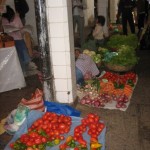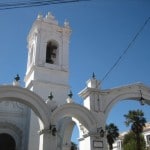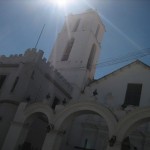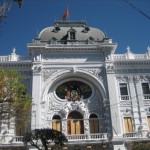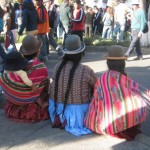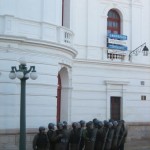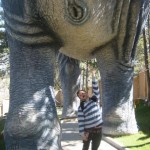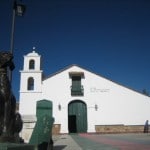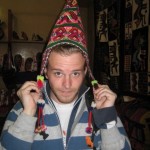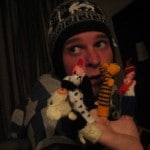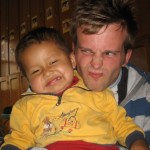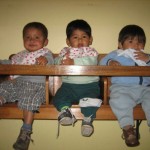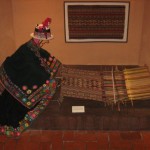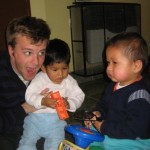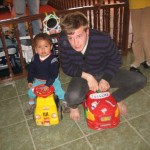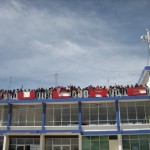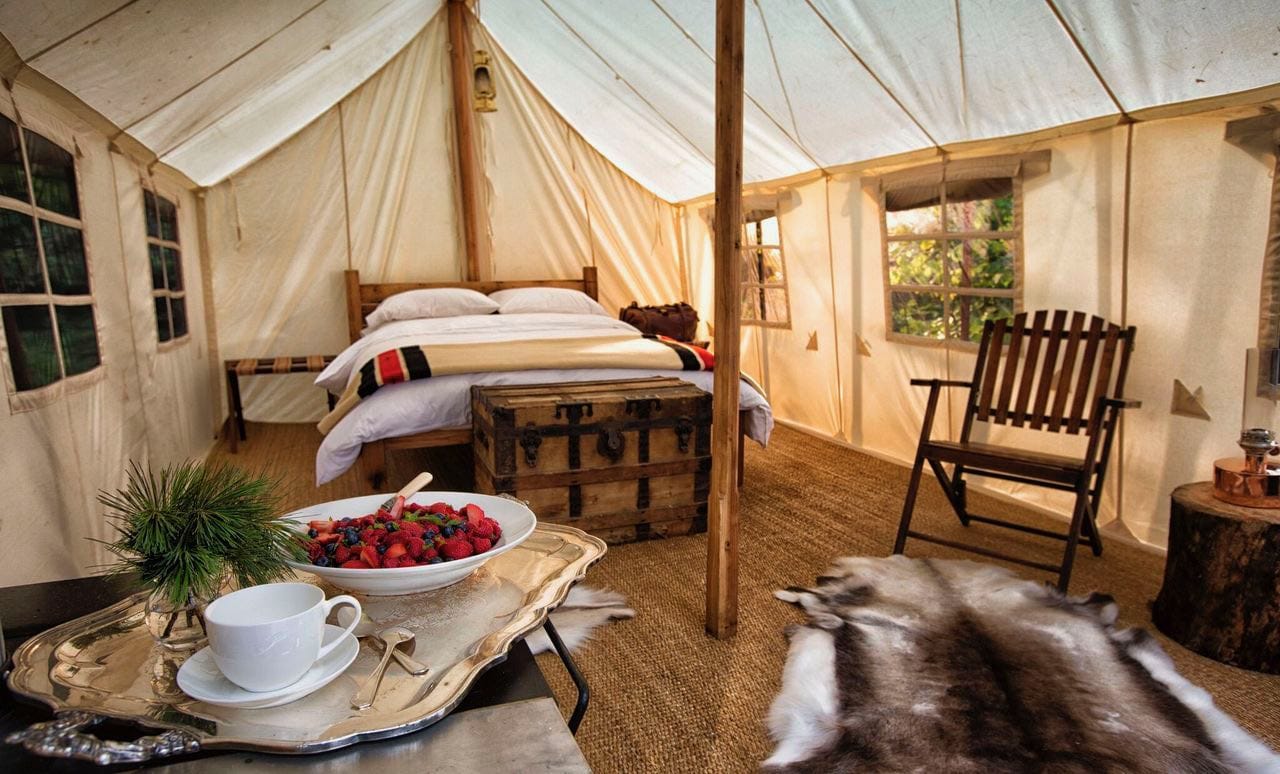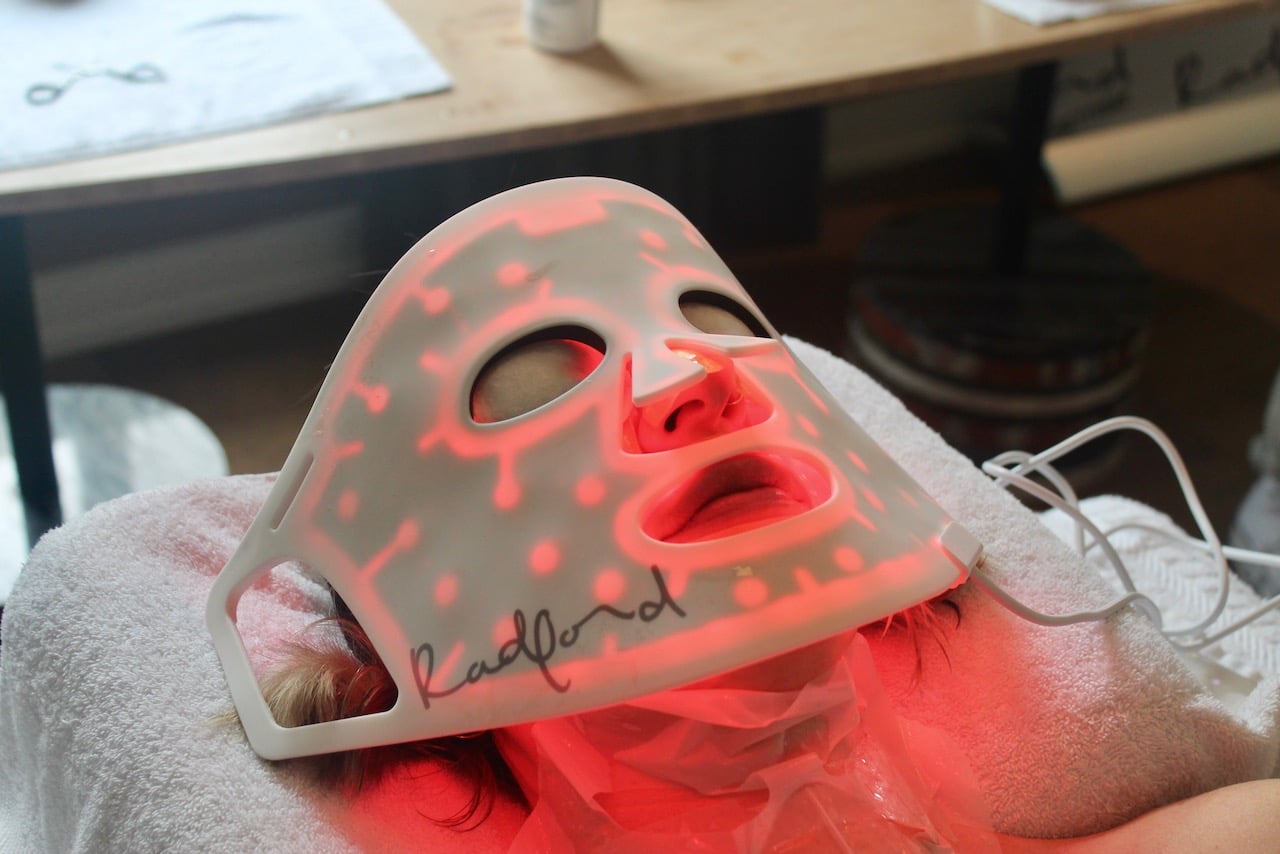HI Sucre Hotel is listed in Lonely Planet as the best hostel in all of Bolivia. This old Rococo mansion has been renovated beautifully for travelers staying in the nation’s cultural capital. The hotel is full of comfy antique chairs and couches, glass chandeliers and opulent mirrors. We got ourselves a private double room for a mere five dollars a night. Once we had thrown all our things down onto the bed we headed outside and walked down a block to the busy main street which leads to the center of town. We were told by the man at the front desk that there was a very good pizza place just on the corner. Very good pizza is a very subjective term here in South America but we wanted to check it out. The place is located in a garage and the back features a huge wood burning pizza oven. We ordered a large pizza espanole (chorizo sausage) and walked down the street until it was ready to take back to the hostel. We popped into a cafe which was open and bought chocolate dipped donuts and a big bun full of dulce de leche. We literally inhaled our fantastic pizza with a bottle of orange fanta. We commented on how this pizza was as good or better than pizza you can get at home. I chirped that I was going to eat this pizza every night that we were in Sucre. Our first shower in over four days was like heaven. It is amazing how a hot steamy shower can totally relax and calm the senses. I was ever so excited to see the quality of bathrooms. Basically happiness is based on quality of bathroom here. If our luck didn’t get any better, we soon found out that the shower was fed by a hot water heater. So no chances of getting electrocuted during the daily scrub a dub dub!
In the morning we opened up the city map and noticed over 26 cathedrals, chapels and convents in the city. The constitution was signed here, every major war or legal battle took place in Sucre and it is a city full of colonial buildings. Located 2000 meters closer to sea level then the high altitude we were dragging ourselves through in Potosi. We walked back to the cafe that we grabbed some sweet treats at the night before. The establishment has a great glass display case at the front entrance full of decorated cakes and pastries. We sat at a four top up a small flight of stairs and my mouth dropped when I saw a life size copy of Michelangelo’s Pieta. The restaurant is full of copies of famous statues and paintings. I love a good copy because you can touch it with your hands without being attacked by screaming Italian museum Nazis! We ordered the Americano breakfast which was a nice attempt but still not any where near what any American would eat for breakfast. I ordered a cafe con leche which ended up being a small bowl of cold espresso and a cup of warmed milk. We were given a big roll (which I assume was supposed to be toast) that was full of cold cheese. We were given a plate of scrambled eggs and ham which was a bit on the cold side. They didn’t´ have any orange juice so I had a glass of banana juice which was rather pulpy.
We decided to walk into town and on the way sat on a bench with an amazing view over the city center. The city is located in a small flat valley surrounded by rolling hills. Every day in Sucre provided great sun and it was a pleasure that our first day warmed our bodies as we had not felt the delights of good weather in ages. From our look out we walked down a flight of stairs and noticed the sound of fire crackers blasting into the air in the distance. Firecrackers seem to be a Bolivian national past time. From above the entire city seems to be made of colonial Spanish tile roofs. As we walked down the stairs we stopped by several residences with open patios and terraces that looked out onto the cities Metropolitan Cathedral in the distance.
We arrived at the cities huge open market. Each vendor at the market (whether he or she had an official stall or sat on their haunches with a few items on a little blanket) specialized in certain goods. One lady specialized in old batteries (a lucrative enterprise in¬ sure). Another older woman had an amazing assortment of stickers and plastic flashlights. After walking through the cheesy dollar store street market we headed into the large indoor market. Pyramids of oranges, bananas and apples abound. The vile stench of chicken guts and raw room temperature meat made my eyes roll back into my head. We left the market and walked in the direction of the center of town. We stopped by an ATM as Sarah was out of money. In the middle of a busy street ATM’s can be somewhat of a risk. I stood directly behind her and watched for crooks and killers. As soon as she walked to the ATM a small group of children
started to moan and shove their hands under my nose.
We arrived at the Plaza de Mayo a glorious central square covered in gardens and tall palm trees. The cities most famous cathedral is located on the square amongst several federal buildings. We were soon entertained by the plazas notorious shoe shining boys. Parents send their ten year old boys out to the streets every day with a little wooden shoe shining kit. A cute little boy asked Sarah if he could have a cone of ice cream. She said yes as it was only one boliviari (about 10 cents). As soon as the little boy had his mouth around that ice cream an army of little boys ran around her. I was sitting on a bench staring at them a few meters away. It was a hilarious sight as Sarah was surrounded by about ten boys screaming for ice cream. After buying the little kids their dessert she sat beside me and we chatted with a couple of them. The kids were obnoxious rude brats to be honest. We asked them their age. One boy said he was 100, the other said he was 99 years of age. When we asked them their real age they insisted we buy them another ice cream. One boy who arrived a bit late for the ice cream splurge came up to Sarah and insisted she buy him a cone. The ridiculous aspect of the conversation was that the boy already had an ice cream in his hand. She refused to buy him an ice cream when he already had one. He sat down in a huff and told her she was a “fat girl with no heart.”
One can only take so much verbal abuse from small children so we got up and walked to the center of the square where a monument of the fist president of Boliva is located. I sat beside a lion statue and we stared out at the many tourists sitting in the sun under the intermittent shade of the palm trees above. We soon realized the reality of the third world as we were swarmed by beggars and street kid’s moments after sitting in our new location. We stared at a white girl with blond curls sitting on a bench directly across from us who was completely surrounded by nine shoe shining boys. They sat and just stared at her as she read from her small paper back novel. She looked up every so often hoping they had left. Her face was all screwed up and awkward. It was a rather entertaining sight. The shoe shiners are adamant about shining your shoes. I saw three of them sitting by a Japanese tourist who was wearing synthetic hiking boots. They insisted his boots needed to be shined even when he said they weren’t made of leather. When in Sucre, shine your shoes.
It wasn’t hard at all to notice the many riot police who walk up and down the streets of the city. They are everywhere, whether that was a good or bad thing we were unsure. We walked up a little street full of pubs, bars and restaurants directly adjacent to the Cathedral. As we browsed the street side menus a terrifying animal we think may have escaped from hell followed us. This small mutt had one normal eye and the other was an empty rotting socket. At first glance I jumped several feet into the air in absolute terror. It passed by me and I told Sarah to take a look at it, she almost vomited. We soon realized its foul odor was from the smeared shit all over its fur coat. We briskly walked away and to our horror it continued to follow us. Sarah and I are adamant animal lovers but we were screaming at the top of our lungs (and crawling up the side of the cathedral wall) as this demonic beast tried to jump up on us. I had to close my eyes when it looked at me as it was so frightening. We made a bolt for it as a few locals laughed at us. Once we were sure we had lost the Thing Sarah muttered that with our luck The Thing was God in doggy flesh testing our moral sensibilities. If so we failed the test miserably.
We stopped into Joy Ride Cafe which is a little joint full of tourists. The restaurant is owned by a Dutch family and prides itself on serving safe food (salads are actually safe to eat as they are disinfected). The menu actually has little blurbs such as “cleaned to kill them bugs.” We sat in the back of the restaurant at a cute little open terrace. The menu has a considerable drink list including over twenty micro brews. Sarah and I shared a chicken curry and pineapple sandwich and I slurped on an Amaretto and fresh orange juice cocktail.
After the quick snack we walked past the spot where we had encountered The Thing (we made sure to bob our heads in both directions to make sure it was out of sight). We arrived at the Iglesia La Merced which was built in 1550. The small cathedral represents the maximum expression of the Baroque style with wooden carved altar pieces and incredible gold leaf decorations. We walked up a winding staircase with the help of an adolescent boy (who seemed to be following us inside the empty church in case we decided to slip an ancient and priceless crucifix into our backpacks). We walked up a winding staircase past an antique organ until we reached the roof top look out. Surrounded by three huge church bells we could see across the cutesy city center. I commented on the fact that we were experiencing the most ideal weather (a slow breeze and sunny sky’s).
We bid the small fellow goodbye and walked to the Metropolitan Cathedral just as it was opening from siesta closure. We first visited the Cathedrals two museums. The first was full of several 18th century religious paintings. A small collection by an Italian (an apprentice of the famed Raphael) who apparently came to Boliva to paint at the Jesuit Missions. We walked into the second and larger museum which featured several wooden sculptures of St. Francis in ecstasy (a little bit of the stigmata experience for you). Sarah and I puttered through the rooms chatting about early Christian history. It always fascinates me to discuss how man treats religion. Sarah is always so insightful as she is majoring in Religion and Literature and has read copious texts on the subject. I contributed a great deal of my art history knowledge by describing various iconographic elements in the paintings as well as stylistic components (an ode to chiaroscuro). We walked into a huge room full of little religious artifacts and gems. Overhead two huge white angels blew horns into the sky above. In the center of the room an early Hearse could be found (that’s what I like to call it). The elaborately painted wooden contraption was used to transport dead bodies. On the central panel a skeleton is depicted (father death) who holds in one hand a huge sword and in the other a running sand time piece. Seems like when your time is up, your time is up. What a lovely reminder as your dead body is being lugged across the city. My favorite pieces were two wooden statues of small little boys who had severed heads, San Pastor and San Justo.
After leaving the museum we were greeted by a short lady with heavy brown hair who would be our private tour guide of the cathedral and chapel. As she turned the huge iron key in the ancient door lock she pushed through and the smell of old filled my nostrils. The Cathedral is famous for its Virgin of Guadalupe Chapel. As we walked in front of the glass case I was a bit stunned by the tacky Christmas lights surrounding the Virgin. We were told that the Virgin is from the 1600’s and represents the protector of the city (much like the Virgin in Sienna). The Virgin has become a famous piece of Sucre’s religious history. Years ago people started to bring precious stones, jewels and gold pendants which have been added to the attraction. Apparently every day at 8am the chapel is full of locals and pilgrims who come before the Madonna to pray. We walked outside of the chapel down the aisle of the Cathedral. We were told that the original style of the church was of flashy Baroque but when Bolivia fought and won its independence from Spain the necessary change in religious theology required a resuscitation of the neoclassical style. Our guide pointed out several beautiful silver religious artifacts that she said were mined in the city of Potosi hundreds of years ago. As we walked back to the entrance our guide said sadly they have to put many security measures into place when allowing people access to the Cathedral. In the past many locals have stolen priceless artifacts from the church. I realized the Cathedral must have been far more opulent when it was first built. You can tell that areas of barren wall now exist
simply because of thieves.
We waved goodbye to our guide and stepped into the sunny afternoon heat. We walked around the corner of the Cathedral and sat on the steps for a few seconds to re-hydrate and figure out what to do next. That decision was soon made for us. I noticed directly in front of us a larger tanker riot truck with several riot police filling the vehicle with water from the near by hydrant. In a few seconds we realized what was going on around us. Thousands of people holding banners, waving flags, screaming, lighting bomb blasting fire crackers marched directly in front of us. We groped the wall standing a safe distance from the protesters on the street. I have never seen such impassioned people in my life. The banners represented many different groups of people who want to fight the government as they are trying to privatize universities across the country. Protesters actually started to throw bottles and other random items at the riot police. I thought to myself “ we shouldn’t be standing behind an armored car and a gang of riot police.” We watched the chaos and laughed as we saw several tourists amongst the snaggle tooth locals with babies on their backs. I guess something can be said for being involved in a rather exhilarating march. Bolivian flags, stripes of red, yellow and green could be seen across the plaza and smoke rose above the palms as firecrackers exploded every few seconds. It sounded like war.
We heard folky Bolivian music playing over the loudspeakers. The slowly moving hoard of protesters started to chant the Liberate Bolivia anthem. We started to acclimatize to the general mood around us and as we walked with the liberated crowd we squeezed into the national chocolate shop called Para Ti Chocolates. Nothing like a bag of chocolates to quench a bit of revolutionary fervor. We continued to walk with the protesters to a smaller plaza where most of the federal buildings were located. Reporters and cameras were flashing everywhere. A huge throng of riot police stood in front of the federal buildings in order to protect the government’s interests and were ready to take care of any illegal behavior. We jumped through the crowd and left the riotous minions behind us. We soon arrived at the entrance of the cities lavish park. We couldn’t help but laugh as the park featured several incredibly tacky copies of European monuments. We entered the park under the Arc de Triumph and passed through several gardens to arrive at the Eiffel Tower (which you can actually walk up). Children zipped by us on little electric cars which you can rent at the north end of the park. We debated asking how much the cars cost to rent as it would be pretty hilarious to drive around on miniature electric cars built for six year olds. We could possibly
terrorize small children which is always thrilling.
We spent the evening at La Taverena a high end French restaurant at the center of the city. We entered through a small little door off the main street and walked onto a stony courtyard (where French films are shown on weekends). We sat down at a small table and stared down at our cow skin menus. The restaurant was decorated with antique type writers, a wild collection of Bolivian outdated currency and row upon row of Bolivian wines. Who knew Bolivia had a wine region? I was certainly shocked. The wine growing occurs in the south eastern province, apparently its claim to fame. I ordered us a La Concepcion Riesling which ended up tasting awful (I should not have chosen the cheapest bottle, splurging always yields a good result in Bolivia I have learned). The wine contained no varietal character and was incredibly difficult to swallow. I felt the need to chug it, bad manners I know, but necessary. We nibbled on baguette which was accompanied by hot peppers and sweet mayonnaise. We shared a starter of fettuccine with a pesto cream. I ate a huge plate of honey mustard curry chicken breast with shriveled grapes. We talked at the table while slowly sipping our Bolivian sub standard vino blanco about an hour after we had paid our bill. We stumbled out of the restaurant and hailed a cab. Apparently even if the quality of wine is negligible the
intoxicating features of the grape are still present.
The following day we hopped onto a hilarious Dino Truck. The truck is outfitted with several rows of benches and a t-rex head which jets out above the drivers seat. As we waited to take off we stared out into the plaza where several freshly squeezed orange juice vendors tried to sell us a cup of OJ. It was somewhat embarrassing to drive through town as locals pointed and stared at our ridiculous vehicle. We were headed to the Parque Cretacico, the worlds largest paleontological site, with over 5,000 dinosaur footprints of 332 species. This famous dino park is located directly beside a quarry. Which would explain how the footprints were actually found.
Once we arrived at the park we were greeted by an English speaking guide who took us through the hilarious and fantastical corny statue park. We were told that Sucre 65 million years ago was a lake. It is hard to believe that this whole mountainous area was somewhat flat millions of years ago. We then got our first glance at the amazing cliff face which contains hundreds of huge dino tracks. It was really really weird to realize you were staring at a fossilized footprint of the largest animals to ever roam this earth. I also had somewhat of a fascination with dinosaurs when I was a geeky little child so Jurassic Park moments thumped through my heart. Truly geek. We were told that during the volcanic explosion and resulting tectonic shifts the bottom of the lake was pushed vertically toward the sky and then covered with ash. It was sort of wild to stare at a cliff that used to be horizontal and covered in lake water. Apparently Sucre was the water hole, so to speak, for all of the dinosaurs for Latin America and the northern part of the continent. The guide told us that the world’s top dino doctors from across the globe spent years here studying the footprints. After staring at the dino tracks we were told that we were going to move back in time to the period when dinosaurs roamed the earth. Our guide was so corny and animated we had to laugh. We walked through the entrance and soon realized the park was full of life size replicas of every dinosaur that was identified on the foot print wall. We stared up at the Carnataur (a small Trex with horns on its head used for vicious head butting). A huge replica of the world’s largest animal the Brontosaurus stood behind several trees. We were told the animal measured 36 meters long and 18 meters high. It was fun to walk between the huge animals legs. Talk about serious monster toes. At the end of the tour we had a great view of the cliff again and the tour guide finished by telling us the park cost 860 thousand dollars to build (which is ridiculously expensive considering the value of Bolivia’s currency).
Arriving back at the city center we stopped at an outdoor restaurant, La Repizza, where I drank a bottle of Huari Pilsner and ate a regional specialty. Pailitas con lomito a la plamcha (french fries with steak, chorizo, cheese, egg and tomato). After our mid day snack we walked towards the cities cemetery. We walked past several dino phone booths along the way. It is really hilarious to walk around this architecturally rich city and constantly be reminded of the areas dino history with corny dino shaped telephone booths and posters of scantily clad models posing under dinosaur statues (which you can find in every restaurant, supermarket and bank in this city).
As we arrived to the entrance of the cemetery we noticed loads of vendors on the street selling a vast array of flowers. The cemetery was built in 1580 and its many rows of mausoleums, monuments and beautiful gardens are an excellent spot for a mid day stroll. As we walked into the cemetery gardens several little kids asked if we wanted a tour which we kindly declined. We ended up spending over an hour walking through the cities huge cemetery. It was much different from Recoletta cemetery in Buenos Aires as the dead were buried horizontally along rows of white plastered wall. The coffin drawers feature a locked glass door in which you can look at the spectacular offerings placed here by family and friends of the deceased. Several of these creative sanctuaries featured pictures of loved ones, recent mothers days cards, freshly cut flowers (sometimes the number of flowers could be considered overkill as they almost burst through the glass door). Cemetery attendants (who are around ten years old) walked around the gardens ready to help anyone who needed access to their families mausoleum. They carried tall wooden ladders so they could access, clean and fill the sanctuaries with fresh offerings. I was reminded of the opening scene of the film Volver. The grounds were full of woman tending to the graves of their late husbands, friends or children. They meticulously cleaned the grass, watered the surrounding greenery and propped fresh cut flowers with great care. We sat down for a few moments just to stare at the sheer size of the place. The sun glitted through the tall palm tree branches overhead. The cemetery started to feel a bit weird when we noticed some sanctuaries contained Smurf, Disney and other cartoon character figurines. Sarah found it very odd that many of the glass display cases were outfitted with awnings to protect the contents from the sun and rain!
We stepped outside of the cemetery and flagged down the first taxi. At first we thought it a bit odd as someone was sitting in the front passenger seat. We soon realized that the taxi was a family business. The husband drove, the wife took directions and the baby on her lap was in charge of looking cute. We soon realized that anyone who wanted to make a few bucks could stick a taxi sticker on their car. None of the taxi’s here have meters. Every destination is a fixed seven Bolivar trip (that is just under one dollar). Our taxi driver was clearly not skilled as he got horribly lost trying to find our hostel. His wife seemed to be beating him over the head as she was trying to tell him the right way to get to our destination. After a long day we decided to take a nap. Starting at 7pm…and ending at 11:30pm! Apparently we needed our sleep! We walked to our favorite pizza place and cried on the street corner after realizing it was closed for the evening. The first thing I thought was “This is so not Buenos Aires!” We sat on our beds nibbling on a few cookies and chocolates before heading to bed.
Our alarm rang early in the morning as we had to get our act together to get a bus to the town of Tarabuco. The place to be on Sunday is Tarabuco as the cities streets are spilling with indigenous handicrafts. Native craftsman (particularly weavers) travel to Tarabuco from little villages around the area to sell their beautiful rugs, blankets and clothing. We took a ridiculously long hike to get to the unmarked bus station. We walked past the cities central agricultural depot which was teaming with piles of oranges. Vendors purchase their daily supply of oranges for the day from these trucks and walk around the city offering freshly squeezed juice. This is when I noticed for the first time that the city streets and sidewalks are scattered with orange peels. People grab an orange and chuck the peel on the ground. The result is a town that smells of citrus and a population with no worry of scurvy. We passed a squad of practicing riot police who walked single file with their heads held high. We stood at what seemed like a bus pick up spot where grubby locals sat dazed and confused. We asked around and finally found a bus that was headed to Tarabuco. The following was another ridiculous transit adventure (have I taken any decent buses in this country…I don’t think they exist). We walked onto the bus and I almost heaved at the putrid conditions. The seats had barely any legroom. Our shins pressed into the wiry seat in front of us. We had to wait about thirty minutes as the entire bus filled with locals. I was suddenly wary of our trip as it seems whenever gringos are not present bad news is likely. Our shack on wheels finally left the corner once the interior was overflowing with screaming babies, smelly men and swaying teenagers standing in the aisle. I was lucky enough to have an indigenous women with two white snaggle teeth and gums full of gold sit beside me with her irate son.
The bus stopped at a small town along our three hour bus ride which ended up ascending 2000 meters. Local woman ran to the sides of the bus and offered garbage bags full of grilled Llama meat, corn and potatoes. As our Little Engine that Couldn’t chugged up the mountain side I stared out into the farmland that can be found in between rough mountain terrain. I saw loads of donkeys, sheep and wild hairy pigs. I leaned my head against the window which was covered in stickers of Teletubbies and Jesus Christ. I dozed off for a bit as this bus seemed to be anything but calming. I was suddenly woken up as Gold tooth (this is the mother) actually placed her son on my lap. I was in complete shock. She started to feed him a rotten orange while he sat on my lap and pulled my hair. Parenting and politeness 101 must have been chucked out her window long ago.
We finally arrived in Tarabuco, a small town with a central square just south of Sucre. The sun was blinding (I wont complain about this wonderful sunny weather I swear!) I walked directly into a herd of about ten or so donkeys which were being whipped by a length of grass that a wrinkled old woman had firmly gripped in her aged hands. Tarabuco is a perfect place to spend a warm Sunday afternoon as browsing and bargaining in the market is as close as you get to shopping over here. The town is full of indigenous people wearing (and selling) traditional native garments and trinkets. The men here wear leather skinned helmets decorated with colourful beads. The woman can be distinguished from the men as they wear boxy top hats with a row of inch long beads hanging over their forehead. We spent the next two hours wading around the central square and through the side streets. We became accustomed to little old ladies who threw their hands into our faces and insisted we buy their bracelets. We sat down for a few minutes to hydrate on the corner of the square and had a slew of incredibly interesting characters visit us. During our thirty minute rest we had several visits from the bracelet toting ladies. We also watched several donkey caravans push through the streets. Our favorite visitor was a toothless mother with a newborn sitting on her back wrapped in a traditional weaving. She asked us if we thought her baby was beautiful. We said yes with big smiles on our face. She then asked us if we wanted to have her baby. We both looked at each other as if we didn’t hear right. She started laughing like a mad woman. She asked us how much we would pay for her baby. We sort of awkwardly laughed and she
walked away. Wack jobs abound.
We jumped off our haunches and I rubbed my hands together ready to start my bartering. I have a long history for the love of bartering. As a child I grew up bartering over house hold items that we would sell at our annual garage sale. I am an expert, not to brag. We had already walked across the town and I had been mulling over what items I wanted to buy. I wanted to make sure they were practical and that I would get good use of them back at home (buying an indigenous helmet does not have many practical uses in Oakville). I became enamored with hand woven wall hung rugs. My particular favorite features the backs of three huddled Bolivian woman. The weaver’s attaches two black braids to the back of each head so you can see the hair of these huddled woman coming off the rug. All of the vendors seemed to be selling them for 150 bolivars. I ended up bartering my main man down to an easy 100 bolivars. He knew I had great interest and I just continued to walk away whenever he brought the price down. I happily packed my new wall hanging into my bag and continued along the street. I bought a pair of Llama decorated Alpaca gloves and a traditional Bolivian Alpaca hat.
After we satisfied our shopping cravings we walked back to the donkey farm where all of the buses headed back to Sucre. A Bolivian woman was sitting on the side of the shady street along with several other locals so we went up and asked her when the next bus was leaving for Sucre. She basically told us she had no clue. The street was packed full of locals staring into the sky waiting for a bus to leave. We walked up the street and talked to a driver who said he had two seats available in his bus. We soon realized (based on the quality of seating) that this bus was for tourists. An old indigenous woman actually asked the driver when the bus was leaving and he told her the bus was only for gringos. She left in a huff. We sat down in the bus and in the next few minutes the bus filled with Germans, Israelis and Scandinavian families. We were soon booted from the bus as the driver gave us a seat that was apparently already taken. We sobbed under the hot sun as we sluggishly stumbled to the next tourist bus. We met with a young man who told us he had no seats available in his bus. He told us we could sit in the front of the bus on rugs behind the drivers seat. Ghetto bus journey that would have been. We ended up waiting by the bus for the next thirty minutes hoping that a few of the tourists did not return to the bus on time. Yet another lady selling bracelets came up to Sarah and begged her to buy one of her crafts. Sarah kindly said no thank you but the lady continued to nag her. After asking Sarah about ten times I thought she may actually kick or shove the women away from her. We hopped on the bus as there were apparently two spots. Our hearts leapt out of our chests as we were hot and dying to get back to the city. We sat in our comfy seats and chatted with our friends from Wales who sat in front of us (we have met them at almost every tourist spot in the city). As the bus slowly crept up the hill my heart stopped as two men ran after our vehicle and the bus slowed to a stop. I was dreading having to give up our seats to the rightful owners. Thank the Lord they were just tourists desperately searching for a ride back to the city. I screamed “vamos vamos” and the bus hit the road. To be honest the few minutes where we sat in our seats uncertain of our fate was an edge of your seat anxious thrill. I was loathing having to get back outside in the dead heat.
Once arriving back at the hostel I had a hot shower and sat on a swinging bench overlooking the backyard garden. I stared down at a little red hooded garden gnome and two brightly coloured wooden parrots. In the next hour or so I watched the sun set behind the huge palm tree in the middle of the garden. I started reading The Switch by Sandra Brown as hundreds of dogs barked and howled at the glowing full moon. I woke Sarah from her nap and we walked back down to Mana Pizza and devoured our favorite Pizza Espanol with a bottle of Fanta. The pizza seemed to taste even better than our first introduction to the thin cheesy delicacy. Perhaps that was because we hadn´t eaten a proper meal in 36 hours. We went to bed with raspy throats and before we fell asleep it sounded as though we were both coughing up a lung.
In the morning we decided to go for round two at Joy Ride Cafe as we knew the food was alright but above all safe for our tummies. I ordered the house salad which was loaded with olives, cheese cubes, roasted Brazil nuts, croutons and honey mustard dressing. I also ordered a large plate of Chile con carne and guzzled down a Corona. After waiting some time for our meal I felt compelled to order one of the Dutch dishes on the menu. I ended up over eating (obviously) as I signaled the waitress to order a serving of Bitterballen with mustard. My stuffed up noise made eating rather awkward. My corona tasted incredibly odd as I had a skewed ability to properly use my olfactory glands. In fact everything tasted odd. All I could taste in my mouth was burning hot (as my Chile was erroneously spiced). The combination of spicy beef, beans, beer and mustard gave me rather instant bowel grumbles. It was on this fine day that my four day long battle with dysentery commenced.
After a rather lengthy visit to the men’s room we walked into the square to find ourselves a Pharmacy. We purchased multivitamins and flu medication for babies and toddlers at the pharmacy and then walked to the cities nearby market. At the market we purchased several bags of sugar, rice, dehydrated milk powder and a bag of diapers. We grabbed a taxi with all of our goodies and headed to the cities orphanage. We had seen a sign on the hostel bulletin board that the orphanage encouraged willing tourists to come and spend time with the children and listed supplies to donate. We rang the doorbell and stepped into a hallway that sounded of crying babies. We were ushered into the large infant room which has three separate areas to play and feed the babies. The central area is covered in tiled floors where younglings learning to walk can grab onto the back of plastic toy cars. The youngest of the infants (those who are only able to blink, cry and settle on their stomachs) are found in the left hand corner with a comfy padded floor loaded with teddy bears.
I sat across from a little girl wearing a red riding hood who was wailing up a storm. Apparently she had just arrived back from a visit at the hospital due to her raging fever. Sarah and I both became fond of Juan Jose as his face was adorable and full of smiles and giggles. Apparently he had arrived to the orphanage malnourished with a bloated belly. He was now doing fine (although he was incredibly light and needed some meat on his bones). I was then introduced to Marco who would end up being my favorite child at the orphanage. He hated me. Detested me even, at the start that is. His face was incredibly animated. I felt he was somewhat of a princess with his nose in the air. If you did anything that annoyed him his face would form a shrewd little angry grimace followed by a shrieking scream. I first met him as he was pulling himself along the floor with his two little feet on a red plastic mustang. I hopped on a pink corvette and rolled over beside him. He stared at me as if I was insane that I dare come near him. For some reason I was instantly captivated by his ridiculous adult like expressions. He turned his head from me and gave me a “talk to the hand” expression. I played a bit of bumper cars with him. He swotted my hand and screamed at me to leave him alone. And that I did.
Sarah and I chatted with a couple from New Zealand who had been coming to visit the orphanage for the last three weeks every afternoon. They knew each of the thirty infants by name. Jorge a little runt with a head full of black hair loves when I blow on his face. It shocks him initially then his face turns into a big smile. I looked at his small little hands and soon realized this little man had a death grip that made me wince. How do babies who can´t even stand, yet alone walk have the power of Sampson in their arms? I walked back over to Marco and kept my distance so I could observe his mannerisms. He proceeded to throw plastic balls, lego pieces and dolls at me. I was really going to have to work on this one. He rolled his mustang over to me and stopped right in front of my crossed legs. He stared at me for a few seconds, frowned and then screamed in my face.
After a few hours of action packed baby I actually fell asleep on a matt with a tiny baby girl lying on my belly. We spent the last hour of our visit at the playground behind the orphanage. It is here that we met a wired group of four to six year olds. A group of four girls grabbed my jogging pants and insisted that I take them off. I was actually shocked by the hyperactivity of these kids. One of them acted as though he was some wild animal: growling like a lion, spitting like a snake and jumping on our backs trying to kill us I presume. I found it hilarious that whenever one of the kids first meets you they blurt out a few war cries and pretend to be ninjas, flailing their clenched fists in your face. I couldn’t help but laugh at these short little midgets as they tried to intimidate me. I actually went along with the whole charade and started kicking my legs in the air and screaming like a samurai. These older kids were certainly offering a more interactive visit. One of the children terrified me as he chased me around the park with a finger full of boogers. Some children, I have learned, I can do without. Sarah sat with our favorite in the jungle gym who is entirely androgynous. We have no clue if she is a female or male but we love it none the less. It likes to scream, jump and run as fast as possible. It is incredibly tiny, probably a premature birth. Before we left the orphanage the little he-she grabbed Sarah’s shirt and insisted that she see her breasts. These kids are crazy. We took a taxi back to the hostel and devoured another meal of pizza and fanta. We apparently can not get enough of this pizza restaurant. We assume we will be considered regulars sooner than later.
On our last day in Sucre we took a taxi to the sunny Recoletta district. A huge fountain sits in the center of the square where yammering kids kicked around a football. The square also features a white and yellow cathedral and several indigenous craft shops. Tourists make the trip (up hill) to Recolleta to take advantage of the best view of the city. The lookout is located on the cusp of a rolling hill under a beautiful architectural hall flanked by Corinthian columns. We could hear the sound of Italian opera over the speakers bellow and realized a cute little cafe situated within a beautiful garden was open for business. We stepped into Cafe Gourmet Mirador which overlooks the city square and huge Metropolitan Cathedral. We sat in rocking lounge chairs under the cool shade of a bamboo and palm tree umbrella. We looked through the menu and I couldn’t help but notice a few fluttering butterflies in the flowers by my feet. I ordered a Tortilla Espanol (omelet with potato, Rosemary and onion) cafe mocha and a banana, apple, papaya and orange smoothie. We read for about an hour while slowly enjoying our brunch. After my last bite my abdomen began to growl and I pouted as I realized my “condition” had still not let up. It seems like it is impossible to avoid food borne illness in this country unless you are willing to spend days eating cookies and drinking coca cola.
We hailed a taxi in the square and drove to the other side of town for our second afternoon visit at the orphanage. We arrived earlier than usual as the babies were still in their cribs waking up from their naps. When we arrived the nanny in charge threw her hands in the air and shoved bottles full of warm milk at us. We ensured that each baby was properly suckling their dairy as nannies rushed to change the baby’s diapers and ready them for play time in the other room. After we had given all of the babies their bottles we were urged to come into the change room and clean the faces and comb the hair of each of the freshly diapered babies. I looked down at the floor and saw three little boys sitting on plastic toilets. I locked eyes with Marco who whined and lifted his little finger up into the air. It is at this very moment that I realized how adorable it is when cute little kids point. Marco is excellent at the art of pointing. As he sat on his plastic trainer toilet he made his finger quiver in the air and it seemed (according to the expression on his face) that the act of pointing was incredibly exhausting and arduous. His eyes would point up at the change table above and shoot back to my eyes as if he was telling me “get me off this toilet now I am ready to be changed.”
We ran the babies who had been freshly cleaned into the play room and after our huff and puff we were beckoned into the visitor’s office where the head nun introduced herself and welcomed us to the orphanage. We spent the next three hours cuddling and playing with the infants. I enjoy just sitting and staring at them as they interact. For some reason I love to see how babies deal with conflict. Whether one is hitting another, pulling their hair or stealing their toy. I noticed two little boys working together and creating a grand scheme to get out of the play room. It reminded me of an episode of the cartoon Rugrats. They were desperate to see what was behind the sliding door. I got a few of the Rugrats onto plastic cars and started an incredibly entertaining bumper car extravaganza. One of the girls is incredibly bright, she can run quickly across the room and fetch anything you point at. She stole a plastic telephone from Marco (which enraged him). When he screamed at her she slapt him across the face. I grabbed her and took her into a corner and spent the next twenty or so minutes talking to her in depth about women’s rights, world politics and issues such as global warming. I tried to instill in her proper manners and explained that slapping men across the face is not at all lady like or socially acceptable. I told her the story of Harriet Tubman and her Underground Railroad which I do believe inspired her. I passionately expressed my belief that fighting with your mind is much better than fighting with your fists or by the sword. She burped, threw up on me and laughed. That’s what you get for trying to advise the leaders of tomorrow! We played with the older kids for an hour or so. Sarah once again had a young boy sit on her lap and grab her boobs. For some reason they are fascinated by gringo bosom.
We grabbed a taxi back to the hostel. Chucked our bags over our backs and walked to the bus station for our 11 hour night bus to La Paz. Or so we thought…After arriving at the bus station we were greeted by huge crowds huddled in front of the bus company counters. We soon found out that rebels had created blockades on all of the countries major highways. No one in the entire country could drive between cities. Therefore all of the buses were canceled and we were stranded. We were told we could keep our ticket and use it for tomorrow if the blockade had been cleared up. We moaned for a few moments, gathered our frustrations and walked back to the hostel insisting that we enjoy an expensive fine dining meal in the city center (expensive translates to four dollars each).
There are several Swiss restaurants in the city so we asked the man at the front desk which was the best and took a taxi to the restaurant. We arrived at the restaurant to find a group of five men huddled in front of a small TV watching a football match. The restaurant was empty, we asked the server to see the menu (he seemed far more interested in the game then our business). We asked the server a few questions about the Swiss dishes on the menu. As soon as I found out the Swiss Fondu was not made of Swiss cheese but of the hole filled Bolivian rubber that we had seen in the market…we jumped out of our chairs and into the star lit streets. We walked down to the main square and decided to try our luck at a Japanese restaurant. El Wok is decorated with Japanese lanterns, hanging origami and corny cowboy music plays on the computer stereo speakers. Sarah was certain that she was going to order the California rolls. As a resident of Vancouver she is sort of an aficionado on all things Asian. She asked about the sushi rolls and was shocked to find out that the California rolls were not filled with crab but instead were filled with ham! She laughed in total astonishment. How can a California roll contain ham! Ridiculous! I ordered a bowl of Japanese rice and a plate of Torikatsu (breaded chicken with Tonkatsu sauce). After our light dinner we decided to visit a little dessert cafe which we had walked by the last couple of days. On our short walk in the dark we discussed how safe we felt on these streets so late at night. I told Sarah that I thought the streets were safe tonight because all of the hooligans capable of attacking tourists had their eyes transfixed on the football game. We sat at the cafe four top and glanced through a huge sundae and ice cream menu. We soon realized that they only had one flavor of ice cream (Baskin Robins 31 I miss you). We shared a banana split before driving back to our hostel for the evening.
In the morning the hostel was full of buzz. I walked down to the front desk as soon as I woke up and asked if the highways had opened back up for bus service. It was not until today that we truly realized the severity of the situation. It seemed like this bothersome situation could last for weeks. I saw two travelers arrive at the front desk and asked them if they had just arrived by bus. They both laughed and told me their horrific story. They had to hire a cab from Potosi to the blockade (five hour drive). They described the blockade as a torn up war zone. The street was covered in huge boulders and trenches several feet deep and wide had been created to impede all traffic. At the blockade they paid their taxi and walked in the pitch black past these boulders and dangerously wobbled over trenches on small floor boards. At the other side of the blockade they searched for a taxi and drove to Sucre arriving in the early morning. Sarah was in the shower and I was not looking forward to having to tell her the severity of our situation. I asked why all of this was going on and soon realized we were in the middle of a revolutionary revolt. The huge protest march we had seen a few days earlier at the main square was actually a precursor to the situation. Apparently people here are not very happy with their government. Historically Bolivians are known for barricading roads, marching and making life just a little bit too annoying for anyone trying to travel. By the way, it is not just tourists who are upset, locals are also irate at these rebels as zero food can be transported by truck into cities. People are fighting the government for several reasons; the government is trying to privatize the university system. There is a contentious issue over what city is the countries capital. The majority of the country believes Sucre is the rightful capital as the constitution was signed here and all important historical events took place here not La Paz.
I rushed up to the front desk and asked the girl working there if she could phone the local airline and find out how much flights to La Paz are and if we could book the earliest flight out of here. It seemed like a smart idea to fly over these barricades rather then let the situation ruin the rest of our trip by forcing us to consider ourselves prisoners to this city. I sat down and realized how cool it was that I was actually experiencing a critical point in a countries history. On the flip side, I decided it is far more interesting to read about these sorts of historical moments rather than living through them. I filled Sarah in on the whole situation as soon as she came out of the shower. We both marched to the bus station and as we pushed through the door we both comically started to sing Oh Canada. We walked right up to our bus company and insisted that we get our money back. With no hassle we were out of there and in a taxi headed for the center of town. We were dropped off at Kulturcafe Berlin a small German inspired pub. The walls were covered in Otto Dix and the bar was a mosaic of German stickers. I ordered a Pina Coloda and a big slice of lasagna. We shared a plate of sliced and fried potatoes with bacon, onion and fried eggs. Our meal was rather silent as we both started new books. I opened the first couple pages of my last Jackie Collins novels of this trip entitled Hollywood Divorces.
After lunch we walked around the entire plaza looking for the Seatur travel agency on a sweltering hot afternoon. We sat under a shady tree on a green park bench and stared at a rather ironic man. His face appeared to be painted in thick white sun screen. He was clearly paranoid with the prospect of getting skin cancer. Our faces scrunched up as he lit a cigarette and smoked his cancer sticks into the warm breeze. I saw a few shoe shiners approaching on the left so I grabbed the sandals on my feet and threw them in my back. I was certain they would be unable to shine my feet. We sneaked into the office just as it was being opened after siesta and sat down waiting for the anglo agent. We were crossing our fingers and hoping to God that we would be able to get a flight to La Paz as soon as possible considering the current revolutionary road conditions. Our hearts sank as she said the best she could do would be to put us on a waiting list for Monday (it was Wednesday afternoon). We felt entirely helpless and frustrated. She searched the flight schedule again and chirped, telling us there are two seats left for a flight leaving on Friday morning at 10:30am. We both screamed “book them now!” I was ecstatic that we would be able to finally continue our trip I actually gave our travel agent a high five. We held our printed flight tickets in our hands with a protective death grip and hailed a cab for another lovely afternoon at the orphanage.
I was so excited to walk into the orphanage as the little ones recognize us now and get all excited when we poke our heads through the door. I grabbed Juan Carlos and sat him on my chest and he oohed and ahhed and then adoringly put his small little arms around my neck to give me a hug. Both Sarah and I were talking to a couple from Israel about how happy we were to have recently acquired a flight to La Paz. I talked with them for a bit about the Israeli army and what it is like to live in a country where so much bad news is constantly being broadcast over international airways. She said living in Tel Aviv she feels just like a foreigner when turning on the TV and hearing about the dangerous situations in the gaza strip. I have met so many Israelis I can’t wait to visit Israel and get the 50 cent tour. The last hour of our visit was spent feeding the little runts for the first time. We sat the older kids (the ones who could actually sit up on their own) in a row of wooden high chairs attached to the wall. Little Christian was the most horrible child I have ever met. I sat him beside Marco and Julia and he kicked, bit, smacked, punched and screamed at Marco, bringing him to tears. The kid was such a bully I grabbed his hands and stared him right in the face and tried to look as terrifying (and disapproving) as possible. I never realized how messy feeding two year olds can be. While feeding Marco I felt as though I were actually just painting his face with pablum. I wonder if he actually ate any of the food I put in his mouth. We whisked the kids into the change room after they ate and experienced a rather tumultuous diaper changing session. I stood at the front door waiting for Sarah to finish up cleaning her baby and realized I haven´t felt this exhausted in ages. Baby’s are a hand full! On the taxi drive back to the hostel Sarah told me about her conversation with a few of the ladies that work at the orphanage. She said it takes three years for a foreigner to adopt one of their children. So much paper work, meetings and check ups makes adopting these orphans in Bolivia very difficult. Sadly we found out that once these kids turn six years old they are all separated from each other and sent to orphanages for older children.
In the evening we drove down to the square lit up by lamp posts with streets full of teenagers oggling and awing at each other affectionately. We ate at Neapolitan Pizza (our pizza place back at the hostel was closed tonight, we were so shocked and upset). I ordered a pizza with corn, onion, bacon and chorizo with a huge glass of vanilla ice cream and an orange fanta float. We waited around for about an hour as we wanted to see a movie at the local theater. We walked into the lobby to purchase our ticket and realized that the film was dubbed in Spanish, boo to that.
On our final day in Sucre we spent the morning at the Indigenous Art Museum. The museum is associated with many private charities and government organizations who want to educate the public with regards to the history of indigenous weaving and advocate the protection of the craft. The museum store sells hundreds of hand made weavings. Each of these are unique and have a small card attached with a picture of the weaver, where they are from and their name. Fair trade artisan shops are popping up all over Bolivia as tourists demand authentic hand made crafts rather than cheap factory made goods. We walked through the history of the indigenous people of Bolivia concentrating on the tribes of Tarabuco and Jalqá.
We learned about how colour is infused into the wool used to make these decorative fabrics. Two rooms compared the content of male weavings compared to female (traditionally woman were the weavers but now men are being encouraged to create their own individual style). I actually prefer weavings by men as they are jam packed full of action and wild fantastical animals. Visitors to the museum can actually walk down the main hall and watch local weavers creating their crafts. I stared at a man and woman who must have spent days to complete each of their rugs. I have a great appreciation now for the time, art and skill involved in making authentic weavings.
Through our travels in Bolivia we have come across several markets which sell what looks like a paper plate with random garbage on it (predominantly seeds glued together with pieces of bread, ribbon, wool and candy). We finally found out what these are as a room was dedicated to this weird cultural phenomenon. A glass case full of all of these random pieces of garbage also featured a dried up Llama fetus. These piles of garbage are actually called Mesas Ritual a ¨collection of offering made to a deity in exchange for a favour, or a way of saying thank you for something good that has happened.¨ Often a Llama fetus is the main feature of the gift and is buried under the front step of a families new house in order to encourage good luck and prosperity.
We then walked into an impressive gallery full of iron mannequins wearing traditional festival costumes and masks. We watched a small video of a famous Bolivian festival which takes place after the harvest. Men wear elaborate wings made of tin which are decorated with an amazing assortment of bells, feathers and magical lace. We also walked into a room which featured a rather enchanting look at native music and folk. They love to play on big drums, blow on bamboo flutes and play guitars which are made of dried out armadillo carcasses. We walked downstairs to witness a rather horrifying display of skulls. Apparently we were looking at one of the most significant archaeological digs in Bolivian history. They found skulls, crafts and amazing disheveled weavings which have lasted for hundreds of years. The skulls were particularly frightening as braids still clung to the head of the deceased.
Our final two rooms were my favorite as they explained the significance and comparison of the Tarabuco and Jalqa tribes. All Tarabuco weavings feature rows of bright colours and cuddly animals. They look like brightly coloured rainbows. The Jalqa tribal weavings have a black background and feature a chaotic assortment of red animals typically with fangs, horns and huge claws. Once you make the connection between the tribe’s artwork and their location it is easy to understand why it looks the way it does. The Tarabuco live in rolling hills full of sun and rainbow breezes two hours south of Sucre. This would explain their brightly coloured crafts. The Jalqa originated near the city of Potosi, the highest city on earth known for its deadly mines. The Jalqas describe a space called ukhu pacha (interior world). Beings that inhabit this interior world are often confused with the iconography of the Christian devil. These spirits are actually protectors of the miners and are typically given coca leaves as an offering for protection and safety as they work. Inside my head a light went off and I suddenly realized why these tapestries were so dark and mystical. They were supposed to represent what magical dark world lurked bellow the mines.
We walked towards the main square and stopped at a popular patio called Le Cafe. We each ordered a slice of cake which towered a foot high and contained four huge layers of cake. I ordered a slice of Mocha cake and felt compelled later to indulge in a slice of banana and nut bunt. We walked around a small square full of tourist shops which all contained the exact same crafts for sale. We continually wonder how these businesses differentiate their offerings to increase their sales and profits. Competition is fierce! For lunch we walked into the swanky Grand Hotel. We sat outside on the outdoor restaurant patio with a central water fountain flanked by black antique street lamps. The area was dotted with grasses, moss and urns full of flowers. We ordered a promising dish ¨chicken breast fried in lemon sauce with white wine accompanied with noodles and topped with Parmesan cheese.¨ As we waited for our lunch I laughed at some of the rather humorous menu item translations. My favorite being, ¨Special meat, accompanied by potato to the oven, rice of the house and salad to the election.¨ Our plates were laid in front of us and our faces peaked into a mortified grimace. Sarah had been given a plate of chicken giblets attached by nasty cartilage and fat tissue. The lemon sauce was something out of a can and had no trace of white wine. The noodles I wouldn’t tuch but Sarah said they tasted mushy. We declared this meal the worst of our entire trip thus far (and hopefully the last). We barely ate anything and asked the server for our check. He asked if it was not good or just too much food and we both frowned and said it was awful. Sarah has been quoted as saying ¨how can something that sounds so good look and taste so foul?¨ She also made me roll on the floor when she said jokingly ¨ the Diet Coke was delightful, compliments to the bartender.¨ We were both starving so we had a chocolate shop binge and bought four huge bags of chocolate for five dollars. We sat in the square for the last time and stared at the pigeons while reiterating how shitty our lunch had been. We sort of felt taken advantage of as the hotel was so beautiful, I guess you truly cannot judge a book by its cover.
We took a taxi for our last visit to the orphanage. The feeding today seemed messier than the day before. I think I got pablum on about 50% of my clothing. I fell asleep at one point on a blanket with a baby staring at me. She woke me up by poking my eyeball. We saw the head nun giving a tour of the facility to what looked like a wealthy Bolivian couple. The wife was taking a ridiculous number of pictures and had a huge smile on her face. This was my final day with Marco. The boy who initially hated me became my life’s work in the span of four afternoons. An hour before we left Marco had a change of heart which made me so happy. He looked up at me with his eager and agitated face and grabbed my little finger with his hands. He then coaxed me across the room as we had a private walk hand in hand. Just before I left he looked up at me and gave both of my legs a big hug. I am so glad Sarah and I had a chance to volunteer our time working and loving these cute little orphans from Bolivia. As we closed the orphanage door we joked about how wild Marco really is. He is no more than two feet tall but he has the personality and facial expressions of a thirty year old.
We spent our last evening dining at our coveted pizza shop where we ordered the usual. As we devoured our slices one by one my mind dwelt on the idea that I would have to spend the rest of the night packing and preparing for what many have called one of the most dangerous cities in South America. La Paz here I come!




